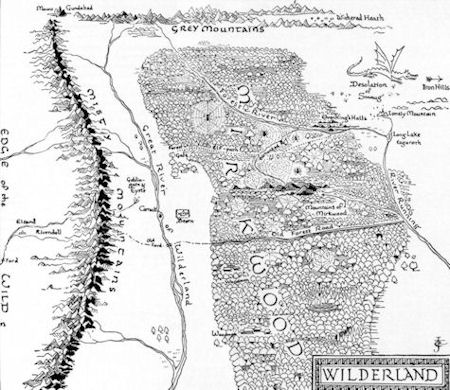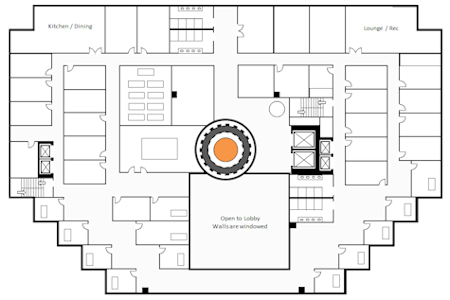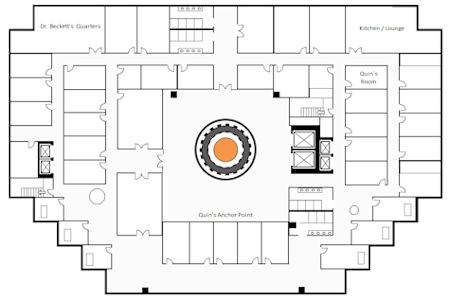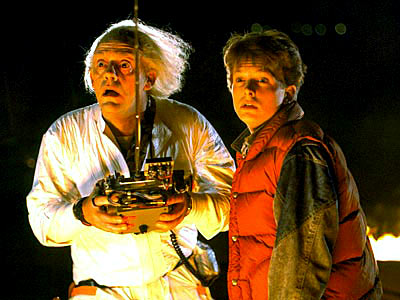I believe the first time I encountered a map accompanying a novel was in The Hobbit. While Tolkien's writing provided wonderfully vivid descriptions of Bilbo's adventures with Gandalf and the Dwarves, there's really nothing like a map to give you an extra thousand words at no additional cost:

A map gives you a solid idea of what's going on that no amount of prose can equal. Which begs the question: is the map a crutch? Certainly a really good book wouldn't need one. After all, isn't it considered literary cheating if you have to literally draw a picture for your readers to help understand your story?
I don't think so. The lack of a map takes away nothing from the story. The addition of the map only adds to the enjoyment of the reader, offering an extra dimension of exploration for those so inclined.
The Map as a Tool
What's easy to forget though, is that the map isn't so much there for the reader's benefit as it is for the author's. When writing a story, a clear view of what's really going on (and where!) is essential for the author. Without that solid image the story might wander or become inconsistent. And what better way to create a solid image than by drawing a map.
As I slogged through the latest draft of Winter's Gate, I began to realize that a particular vagueness to my surroundings was beginning to hurt me. I decided I needed to nail down the layout once and for all.
Maps aren't just for large, sprawling continents like Middle-earth. A large percentage of Winter's Gate takes place in a single building and I simply couldn't go on without a clear vision of this building. So last week, after exploring various tools, I settled on PowerPoint (for 2D) and Google Sketchup (for 3D). I then set about realizing my world. Here are the results.
First, the building exterior:

After kicking around some ideas, it felt like a three story building with a lower level (shown here below the ground line) made sense. Prior to this exercise, I really had no idea how many levels it had. And though I'm showing you the exterior first, this didn't come about until after I'd done extensive work on the 2D floor plans:

Lower Level: where the Generator resides.

Ground Floor: clearly still a work in progress.

First Floor: not much happens here, but I designed it anyway.

Second Floor: a lot happens here (ironically I designed this last).
And the Results?
My single greatest surprise is that many story elements and scenes which I had already worked out no longer fit the new landscape. This is odd, of course. I mean, this is a novel. By definition, it's fiction. I can make whatever kind of building I want and force it to fit the story.
But as it turns out, good fiction really CAN'T be whatever I want. The reader still requires plausibility and consistency. And drawing a clear map of one of my most important settings suddenly pointed out that I had plausibility and consistency issues. It didn't matter how much I liked some of the earlier scenes. It was clear I had darlings to kill.
A Funny Thing Happened on the Way to the Rewrite
As I left the wake for my recently killed darlings, something hit me. The story was about to get better. I re-opened chapter one, with my protagonist Quin's first encounter with that orange ball you see pictured above. I began rewriting the entire scene with this new, clear picture in mind, and wow. Everything got better.
My renewed excitement from a few weeks ago was renewed once again. The story that felt dead in the water last August has had new life breathed into it twice now.
Let's just hope it isn't all for naught.






 As a science fiction movie, Back to the Future should be terrible. It takes tremendous liberties with its "science" and its plot has more holes than a box of donuts. Here are just a few problems I have with the story:
As a science fiction movie, Back to the Future should be terrible. It takes tremendous liberties with its "science" and its plot has more holes than a box of donuts. Here are just a few problems I have with the story:
